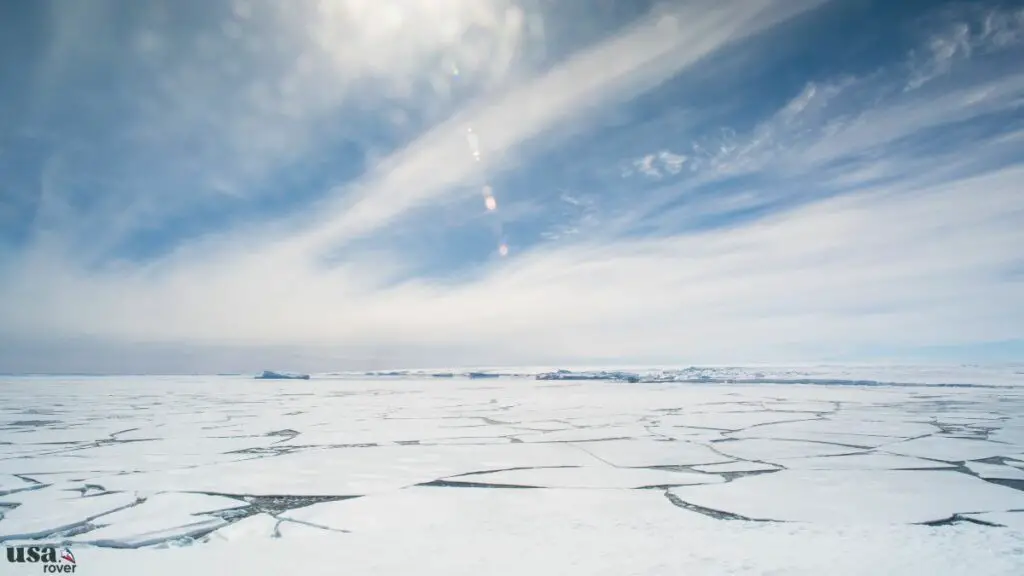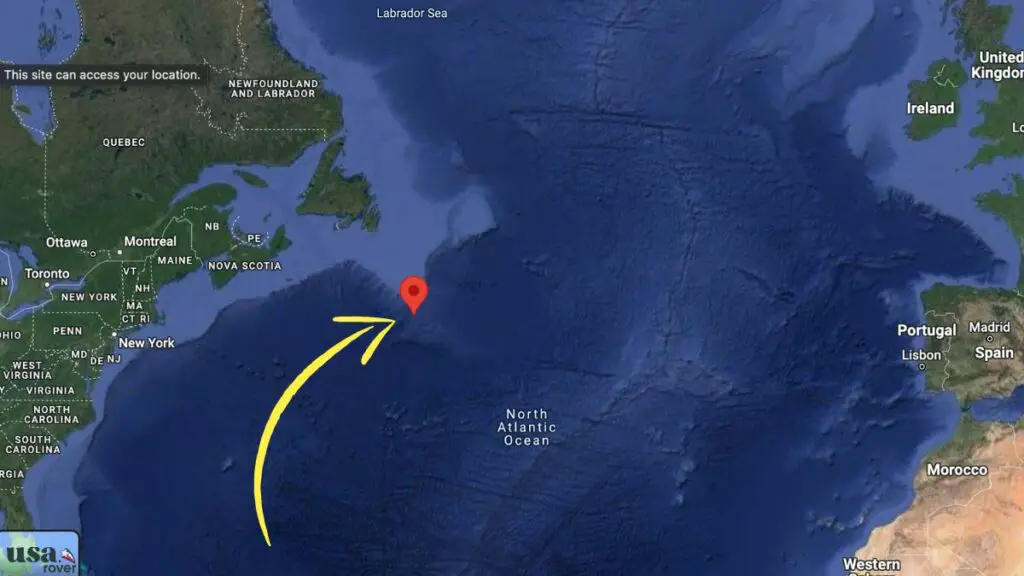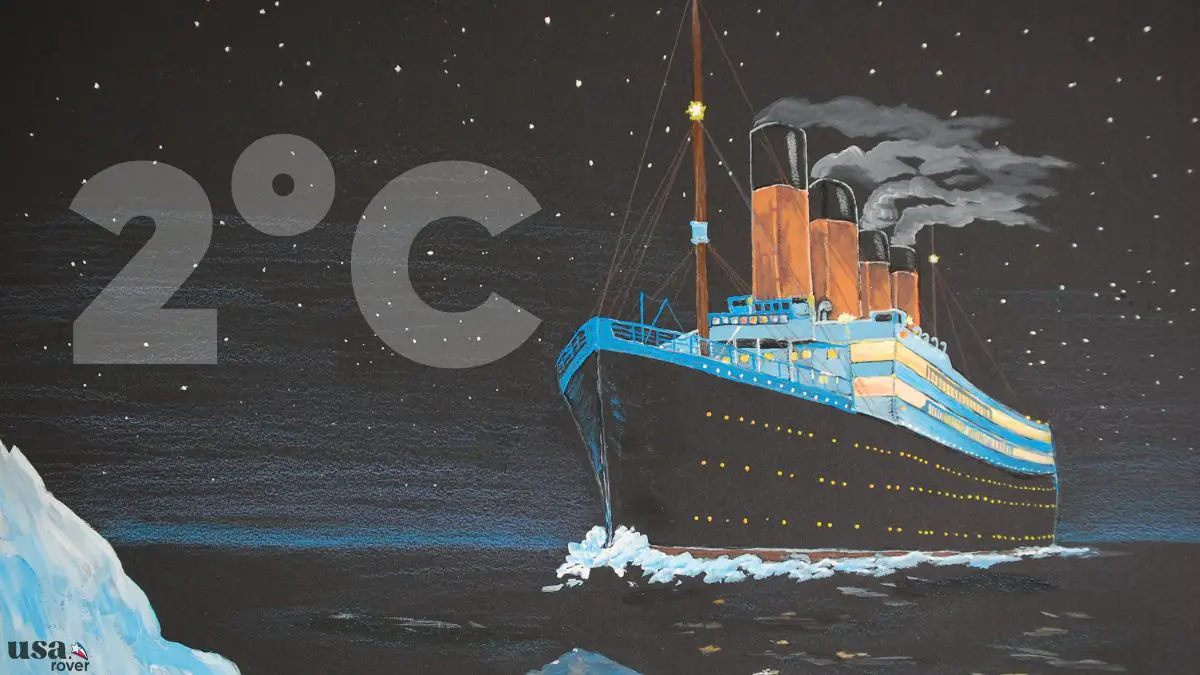The unsinkable ship, as they call it, the Titanic, sank in 1912 after hitting a massive iceberg.
Many people wonder what the water temperature was when the Titanic sank. In this article, let’s see how cold the water was when the Titanic sank and the weather condition at that time.
It is believed that many numbers of people froze to death because the temperature of the water was considerably low.
How cold was the water when the Titanic sank?
The water temperature was around -2°C or 28°F when the Titanic sank in 1912. The temperature of the water was below the melting point, which is zero degree celsius. Many people froze to death as the water temperature was way too low.
The freezing point of the water is 0°C. But still, the water was not frozen because seawater contains more salt, pushing the freezing point further down.
How Long Can People Survive On -2°C Water?

An average human cannot survive for more than 30 minutes in ice-cold water with a temperature of -2°C. It is said that people who fell into the water from the Titanic did not survive more than 30 minutes max.
The exact time a person can survive in -2°C water depends on many factors. Below are some factors that decide how long a person can survive after falling into ice cold water:
- Body fat percentage
- Insulation provided by the clothing
- Whether they wear a life jacket
- A person’s anxiety and stress level
- The person’s body temperature when falling into the water
After about 20 minutes or so, a person who falls into -2°C water would lose consciousness and become completely unable to swim.
Most people on the Titanic died due to cardiac arrest and the sudden shock from falling into cold water.
As soon as people fell into the water, they started to breathe rapidly due to anxiety and panic. This lead to a condition called Hyperventilation. Then they eventually surrender themselves to cardiac arrest.
Was the Cold Water the Cause of Death?
Many believed that people drowned to death after falling from the Titanic. But after reading about the water temperature, you might have a question: Did people die because of the cold water?
Back in the day, it was believed that most people drowned to death. While it’s true, many people die because of hypothermia’s effects.
Due to anxiety and panic, people were not able to swim. If they swam, it would naturally increase their body temperature. Since that was not the case, their body temperature dropped faster than how much the body could regenerate.
How Many People Survived After Falling Into Ice Cold Water?
About 45 people survived even after falling into ice cold water. The number one reason these people managed to survive is that they were either pulled into the lifeboats fast or swam themselves and got into lifeboats quickly.
Charles John Joughin, the chief Baker on the Titanic, is one among the survivor who fell into the water. Charles John did not directly jump into the water. He eventually got into the water with the ship sinking.
He had consumed alcohol before getting into the water, so his body temperature did not lower at a faster rate because alcohol helped him to ease out and not panic.
Normally, a person should last no longer than 30 minutes in the water below freezing point. But when it comes to Charles John Joughin’s case, he didn’t panic and consumed alcohol, which helped him to relieve stress and act calmly.
Furthermore, Charles John Joughin had survived another ship sinking a few years before the sinking of the Titanic. He was on board the SS Oregon that sank in 1886. As it was his second time on a ship sinking, he did not have the shock or panic as the first time, which further helped him to stay calm.
Why Was The Water Too Cold When Titanic Sank?
The water temperature in the north Atlantic ocean is generally around 0°C, below the freezing point of freshwater. There are several reasons why the water was too cold when the Titanic sank.
The ocean depth, the time of the year, weather conditions, day or night, high latitude, etc. are a few factors influencing the temperature of the water.
High pressure cold front from eastern Canada is yet another reason the water was too cold.
As you all know, the Titanic hit the iceberg at night (11:40 PM) and the water was way too cold at night than daytime.
How Cold Is Too Cold?

The average human body temperature is about 37°C or 98.6°F. Even if the surrounding temperature is low, our body can withstand and keep up with it as the human body can regenerate heat, thus increasing the average body temperature. But after a certain point, it becomes impossible for a body to regenerate heat.
Humans can withstand even lower temperatures for more time until hypothermia kicks in.
At some point, our body losses heat faster than it can regenerate. This condition is called hypothermia. -2°C or 28°F is a very low temperature that our body cannot withstand for very long. In a matter of a few minutes, a person would freeze to death at this temperature.
What If The Titanic Sank In the Daytime or in Warm Water?
As you already know, the ocean water temperature drops significantly at night. The temperature would have been much better for the human body to survive if it was daytime.
Had the Titanic sunk during the daytime, many casualties could have been avoided, and the survival rate could also have increased. On the flip side, the Titanic would not have sunk in the first place if it had been daytime as the captain would have seen the Iceberg in the path of the ship already and could have avoided the deadly disaster.
If the titanic sank in warm water, people would survive longer. They would have more time to swim to a lifeboat or wait for help.
The effect of hypothermia is a little over in warm water than in cold water. The human body fights and regenerates heat for more time if the water is warm. As the temperature of the water drops, hypothermia will sit in fast, eventually leading to death.
But this question is pointless as the Titanic collided with an iceberg because the water was colder. If the water had been warm, the Titanic would not have collided with the iceberg in the first place.
Where The Titanic Sank?
The Titanic collided with an iceberg in the North Atlantic Ocean, about 400 nautical miles south of Newfoundland, Canada.
Below is an illustration of where the RMS Titanic sank on 15th April 1912.

The coordinates are: 41°43.35’N 49°56.8’W
This area where the Titanic sank is filled with many iceblocks throughout that time of the year.
The captain of the Titanic saw an iceberg on the path and asked the crew to steer away and reverse the engine.
As soon as they did it, the starboard side of the Titanic collided with an iceberg. This condition resulted in massive damage to the bottom compartment of the Titanic.
The five watertight compartments towards the bottom of the boat got severely damaged, causing the water to let in. The bottom decks were submerged under the sea in a couple of hours, causing the Titanic to collapse and sink.
Why The Titanic Sank?
The Titanic was called the unsinkable ship, yet it sank on its maiden voyage. Its maiden voyage was from Southampton, England, to New York City.
On its way to New York City, the titanic collided with an iceberg in the north Atlantic ocean. After the collision, the bottom decks of the ship took severe damage causing the water to let in. After a few hours, the ship’s watertight compartments were submerged under the sea, and eventually, the ship cracked in half and sank.
Titanic collided with an iceberg at 11:40 PM, 14th April 1912, and sank about two and a half hours later at 02:10 AM, 15th April 1912.
Wrapping Up
The water temperature at the time the Titanic sank was about 28°F or 2°C. Cold water is one of the primary reasons many people die after falling into the water. Since the water was ice cold, many people died due to sudden cold shock and cardiac arrest.
The sinking of the Titanic is one of many horror stories in cruise history. About 1,500 lives were lost in this tragic event.
FAQ
How long did Titanic passengers survive in the water?
Since the water temperature was -2°C, even lower than the freezing point, the people would have survived for a maximum of 30 to 45 minutes. The people on water freeze to death as their body cannot regenerate heat as fast as it was losing – the hypothermia effect. Many people died of cardiac arrest and sudden cold shock.
Did anyone survive in the water when the Titanic sank?
Soon after falling into the cold water, a few people were quickly pulled into the lifeboat. It is believed that more than 1,500 people lost their lives in this tragic event. The ship’s head baker, Charles Joughin, survived the Titanic wreckage.
Is the iceberg from the Titanic still there?
The iceberg that collided with the Titanic was melted entirely by 1912 or 1913. An average lifespan of an iceberg is 2 to 3 years after calving. The iceberg that hit the Titanic is believed to broke off from Greenland in late 1910 or 1911 and completely melted by late 1912 or 1913. The iceberg did not last more than a year after the collision with Titanic.

